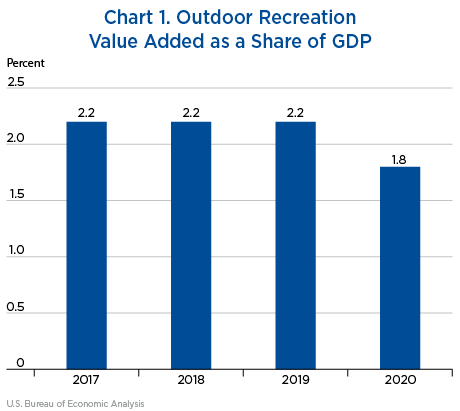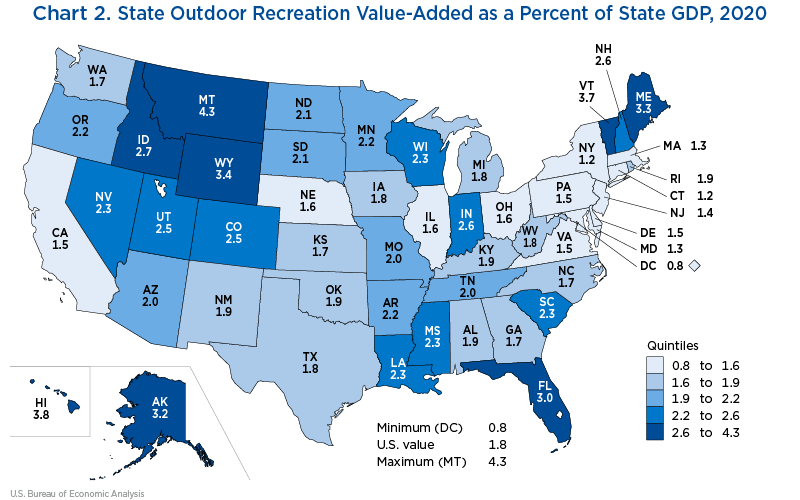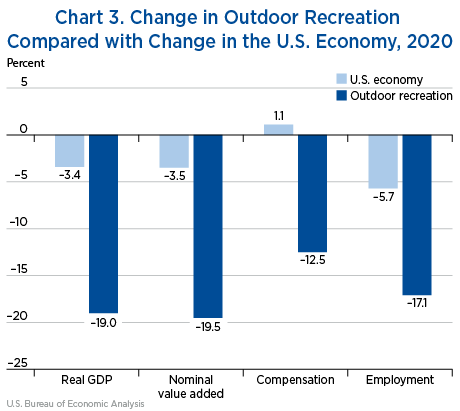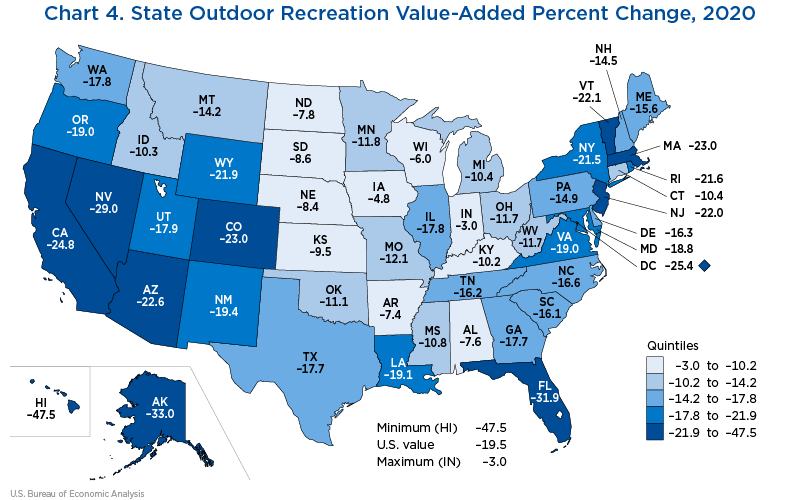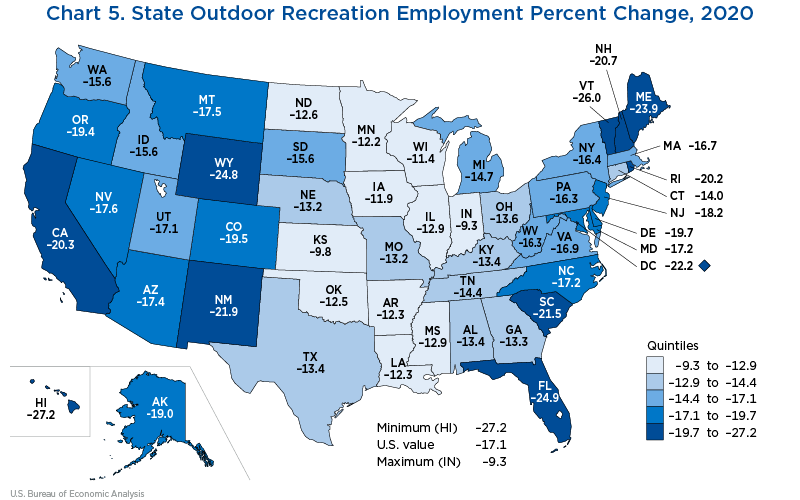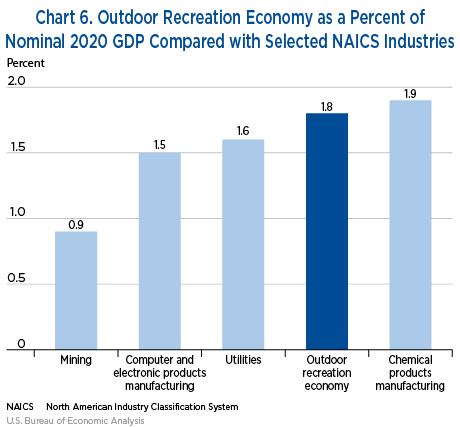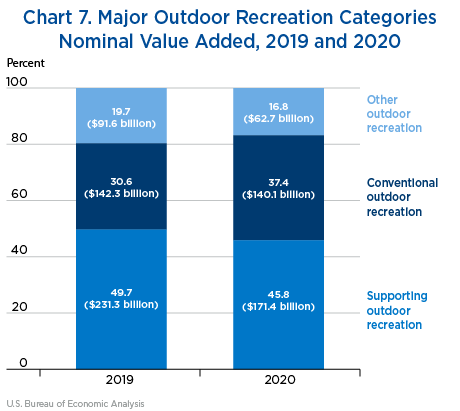Outdoor Recreation Satellite Account
National and State-Level Statistics for 2020
The Bureau of Economic Analysis (BEA) released statistics on November 9, 2021, measuring the outdoor recreation economy for the nation, all 50 states, and the District of Columbia. The new data show that the outdoor recreation economy accounted for 1.8 percent of current-dollar gross domestic product (GDP) for the nation in 2020 (chart 1). This is down from 2.2 percent in prior years.
At the state level, outdoor recreation value added as a share of state GDP ranged from 4.3 percent in Montana to 1.2 percent in New York and Connecticut. The share was 0.8 percent in the District of Columbia (chart 2). The outdoor recreation economy as a share of the total economy was particularly large in the Mountain West states, New England states, Hawaii, Alaska, Florida, and Indiana.
- The outdoor recreation economy contracted more sharply in 2020 than the overall economy as COVID-19 shutdowns and restrictions limited travel and events. Nominal GDP for the outdoor recreation economy declined 19.5 percent in 2020, compared with a 3.5 percent overall decline in the United States (chart 3). Outdoor-related employment as measured by full-time, part-time, and temporary jobs declined 17.1 percent, compared with a 5.7 percent decline for the total economy.
- At the state level, Hawaii had the largest decrease in outdoor recreation nominal value added (−47.6 percent), followed by Alaska (−33.0 percent) and Florida (−31.9 percent) (chart 4). Indiana had the smallest decrease (−3.0 percent). The District of Columbia also decreased (−25.4 percent).
- Decreases in employment supported by outdoor recreation ranged from 27.2 percent in Hawaii to 9.3 percent in Indiana (chart 5).
- Despite the decline in outdoor recreation value added in 2020, outdoor recreation continued to contribute positively to economic growth. When compared to standard industries from the North American Industry Classification System (NAICS), the outdoor recreation economy share of GDP (1.8 percent) was similar in size to utilities (1.6 percent) and chemical products manufacturing (1.9 percent) (chart 6).
BEA's outdoor recreation statistics are presented both by activity and by industry. Outdoor recreation activities fall into three general categories: conventional activities (including activities such as bicycling, boating, hiking, and hunting), other activities (such as gardening and outdoor concerts), and supporting activities (such as construction, travel and tourism, local trips, and government expenditures). Industry statistics show how an industry contributes to all outdoor recreation activities. They are based on NAICS and are consistent with the other industry-based statistics produced by BEA. Outdoor recreation by industry and outdoor recreation by activity are two different ways of looking at the same data, and total values by activity and by industry are identical at both the national and state levels.
Activity results
In 2020, conventional outdoor recreation activities accounted for $140.1 billion, or 37.4 percent of U.S. outdoor recreation nominal value added, compared with $142.3 billion or 30.6 percent in 2019 (chart 7). This increase in nominal share reflects a smaller decline in conventional activity compared with larger declines in both support and other outdoor activities. The decrease in conventional activity largely reflects a decrease in multi-use apparel and accessories that was partially offset by increases in both boating/fishing and recreational vehicle (RV) activities. Conventional activities as a share of total outdoor recreation value added increased in all 50 states and the District of Columbia. Indiana (59.7 percent) was the state with the largest share of its total outdoor recreation economy tied to conventional recreation in 2020 (table 1). The high share was due to the concentration of RV manufacturing in the state and increased sales of RVs during the pandemic. Apart from Indiana, New Hampshire and Wisconsin were the other states with the largest shares of conventional activities in 2020. New Hampshire's share was tied to boating/fishing and RV activities, while Wisconsin's share was tied to boating/fishing and bicycling activities. Indiana, New Hampshire, and Wisconsin were also the top states with the largest share of conventional activities in 2019.
Other outdoor recreation accounted for $62.7 billion, or 16.8 percent of value added in 2020, compared with $91.6 billion, or 19.7, percent in 2019. The decrease in share in 2020 was driven primarily by declines in amusement parks/water parks, festivals/sporting events/concerts, and game areas (includes golfing and tennis). In 2020, the share varied significantly across states, ranging from 21.2 percent in Illinois to 4.6 percent in Alaska. The low share in Alaska in 2020 compared with the state share of 10.9 percent in 2019 was due to the sharp decline in guided tours/outfitted travel services. The other outdoor activities share was also lower in 44 states and the District of Columbia in 2020 compared to 2019. Florida, the state with the largest piece of its outdoor recreation economy related to other outdoor recreation in 2019 (25.6 percent), had its share decline to 18.5 percent in 2020. This was due to a decline in tourism and closures and restrictions in amusement parks/waterparks.
Supporting activities, the largest category in 2019 and 2020, accounted for $171.4 billion, or 45.8 percent, of value added in 2020, down from $231.3 billion, or 49.7 percent, in 2019. Supporting activities, particularly travel and tourism-related outdoor activities, declined in 2020 as consumers traveled less and reduced spending at hotels and restaurants during the COVID-19 pandemic. Supporting activities as a share of total value added decreased in all 50 states in 2020. The District of Columbia was the only geographic region with a higher share in 2020 compared to 2019. In 2020, the share was largest in the District of Columbia (76.5 percent), followed by Hawaii (70.6 percent) and Alaska (69.0 percent). In 2019, Hawaii (76.8 percent) was the top state, followed by Alaska (71.9 percent). The large decline in air travel in 2020 was a major factor in the decrease in supporting activities for states such as Alaska and Hawaii, accessible primarily by air or located far from large population centers.
| Region | Levels (millions of current dollars) | Shares of total (percent) | ||||||||||||
|---|---|---|---|---|---|---|---|---|---|---|---|---|---|---|
| Total outdoor recreation | Conventional outdoor recreation | Other outdoor recreation | Supporting outdoor recreation | Conventional outdoor recreation | Other outdoor recreation | Supporting outdoor recreation | ||||||||
| 2019 | 2020 | 2019 | 2020 | 2019 | 2020 | 2019 | 2020 | 2019 | 2020 | 2019 | 2020 | 2019 | 2020 | |
| United States | 465,183.7 | 374,266.5 | 142,310.2 | 140,137.2 | 91,567.0 | 62,727.9 | 231,306.5 | 171,401.4 | 30.6 | 37.4 | 19.7 | 16.8 | 49.7 | 45.8 |
| Alabama | 4,574.8 | 4,228.6 | 1,725.6 | 1,722.5 | 751.8 | 645.5 | 2,097.4 | 1,860.6 | 37.7 | 40.7 | 16.4 | 15.3 | 45.8 | 44.0 |
| Alaska | 2,348.3 | 1,573.1 | 403.8 | 415.0 | 256.5 | 73.0 | 1,688.0 | 1,085.2 | 17.2 | 26.4 | 10.9 | 4.6 | 71.9 | 69.0 |
| Arizona | 9,881.2 | 7,650.3 | 2,349.7 | 2,403.2 | 1,690.7 | 1,167.3 | 5,840.8 | 4,079.7 | 23.8 | 31.4 | 17.1 | 15.3 | 59.1 | 53.3 |
| Arkansas | 3,140.8 | 2,909.7 | 1,225.5 | 1,188.7 | 444.6 | 368.6 | 1,470.7 | 1,352.5 | 39.0 | 40.9 | 14.2 | 12.7 | 46.8 | 46.5 |
| California | 59,175.1 | 44,498.2 | 15,605.0 | 14,966.2 | 12,556.3 | 7,843.6 | 31,013.8 | 21,688.4 | 26.4 | 33.6 | 21.2 | 17.6 | 52.4 | 48.7 |
| Colorado | 12,403.7 | 9,556.0 | 4,164.9 | 3,753.9 | 1,727.1 | 1,285.9 | 6,511.7 | 4,516.2 | 33.6 | 39.3 | 13.9 | 13.5 | 52.5 | 47.3 |
| Connecticut | 3,682.1 | 3,297.5 | 1,407.8 | 1,411.4 | 749.7 | 572.1 | 1,524.7 | 1,314.0 | 38.2 | 42.8 | 20.4 | 17.3 | 41.4 | 39.8 |
| Delaware | 1,363.1 | 1,140.8 | 341.6 | 334.1 | 179.9 | 122.9 | 841.5 | 683.8 | 25.1 | 29.3 | 13.2 | 10.8 | 61.7 | 59.9 |
| District of Columbia | 1,628.4 | 1,214.7 | 147.0 | 140.2 | 269.8 | 145.3 | 1,211.5 | 929.2 | 9.0 | 11.5 | 16.6 | 12.0 | 74.4 | 76.5 |
| Florida | 48,757.5 | 33,181.7 | 10,321.5 | 10,455.7 | 12,937.7 | 6,125.4 | 25,498.3 | 16,600.6 | 21.2 | 31.5 | 26.5 | 18.5 | 52.3 | 50.0 |
| Georgia | 13,123.3 | 10,802.8 | 4,531.9 | 4,387.9 | 2,391.6 | 1,807.6 | 6,199.8 | 4,607.3 | 34.5 | 40.6 | 18.2 | 16.7 | 47.2 | 42.6 |
| Hawaii | 6,016.3 | 3,160.0 | 605.0 | 621.5 | 792.4 | 298.6 | 4,619.0 | 2,240.0 | 10.1 | 19.7 | 13.2 | 9.4 | 76.8 | 70.9 |
| Idaho | 2,502.6 | 2,243.6 | 979.2 | 1,006.3 | 320.3 | 257.5 | 1,203.1 | 979.8 | 39.1 | 44.9 | 12.8 | 11.5 | 48.1 | 43.7 |
| Illinois | 16,615.2 | 13,659.7 | 4,762.4 | 4,493.2 | 3,927.3 | 2,889.2 | 7,925.5 | 6,277.3 | 28.7 | 32.9 | 23.6 | 21.2 | 47.7 | 46.0 |
| Indiana | 10,154.0 | 9,845.7 | 5,574.0 | 5,873.1 | 1,821.1 | 1,492.0 | 2,758.9 | 2,480.6 | 54.9 | 59.7 | 17.9 | 15.2 | 27.2 | 25.2 |
| Iowa | 3,748.8 | 3,567.9 | 1,522.7 | 1,527.4 | 837.0 | 719.1 | 1,389.1 | 1,321.5 | 40.6 | 42.8 | 22.3 | 20.2 | 37.1 | 37.0 |
| Kansas | 3,350.6 | 3,032.4 | 1,304.6 | 1,228.5 | 567.3 | 469.2 | 1,478.7 | 1,334.7 | 38.9 | 40.5 | 16.9 | 15.5 | 44.1 | 44.0 |
| Kentucky | 4,511.5 | 4,049.5 | 1,491.4 | 1,482.5 | 789.5 | 637.0 | 2,230.7 | 1,929.9 | 33.1 | 36.6 | 17.5 | 15.7 | 49.4 | 47.7 |
| Louisiana | 6,805.3 | 5,507.2 | 2,047.4 | 1,993.4 | 811.8 | 612.8 | 3,946.0 | 2,901.0 | 30.1 | 36.2 | 11.9 | 11.1 | 58.0 | 52.7 |
| Maine | 2,690.3 | 2,269.8 | 837.3 | 892.6 | 225.9 | 172.8 | 1,627.1 | 1,204.4 | 31.1 | 39.3 | 8.4 | 7.6 | 60.5 | 53.1 |
| Maryland | 6,786.6 | 5,511.4 | 2,049.4 | 1,992.3 | 1,308.4 | 928.3 | 3,428.8 | 2,590.8 | 30.2 | 36.1 | 19.3 | 16.8 | 50.5 | 47.0 |
| Massachusetts | 9,995.1 | 7,693.5 | 2,746.6 | 2,762.9 | 2,434.1 | 1,573.9 | 4,814.3 | 3,356.7 | 27.5 | 35.9 | 24.4 | 20.5 | 48.2 | 43.6 |
| Michigan | 10,620.1 | 9,518.6 | 3,925.1 | 3,930.4 | 2,168.9 | 1,701.8 | 4,526.1 | 3,886.4 | 37.0 | 41.3 | 20.4 | 17.9 | 42.6 | 40.8 |
| Minnesota | 9,534.5 | 8,405.9 | 3,442.0 | 3,412.8 | 1,949.7 | 1,587.0 | 4,142.8 | 3,406.2 | 36.1 | 40.6 | 20.4 | 18.9 | 43.5 | 40.5 |
| Mississippi | 2,962.9 | 2,641.9 | 1,076.4 | 1,060.1 | 374.9 | 335.8 | 1,511.6 | 1,246.0 | 36.3 | 40.1 | 12.7 | 12.7 | 51.0 | 47.2 |
| Missouri | 7,337.5 | 6,451.0 | 2,694.6 | 2,699.9 | 1,639.5 | 1,196.2 | 3,003.4 | 2,555.0 | 36.7 | 41.9 | 22.3 | 18.5 | 40.9 | 39.6 |
| Montana | 2,605.7 | 2,236.9 | 909.9 | 943.2 | 389.4 | 365.8 | 1,306.4 | 927.9 | 34.9 | 42.2 | 14.9 | 16.4 | 50.1 | 41.5 |
| Nebraska | 2,382.5 | 2,181.6 | 898.0 | 877.2 | 465.1 | 398.6 | 1,019.4 | 905.8 | 37.7 | 40.2 | 19.5 | 18.3 | 42.8 | 41.5 |
| Nevada | 5,597.5 | 3,976.9 | 1,244.7 | 1,224.0 | 890.8 | 494.8 | 3,462.0 | 2,258.1 | 22.2 | 30.8 | 15.9 | 12.4 | 61.8 | 56.8 |
| New Hampshire | 2,645.6 | 2,261.4 | 1,147.1 | 1,101.5 | 393.9 | 299.0 | 1,104.6 | 860.9 | 43.4 | 48.7 | 14.9 | 13.2 | 41.8 | 38.1 |
| New Jersey | 11,170.0 | 8,711.3 | 3,185.8 | 3,029.3 | 2,470.4 | 1,654.0 | 5,513.8 | 4,028.0 | 28.5 | 34.8 | 22.1 | 19.0 | 49.4 | 46.2 |
| New Mexico | 2,343.4 | 1,889.6 | 641.1 | 612.8 | 241.2 | 178.8 | 1,461.0 | 1,098.0 | 27.4 | 32.4 | 10.3 | 9.5 | 62.3 | 58.1 |
| New York | 26,863.7 | 21,092.4 | 7,364.3 | 7,018.6 | 5,874.5 | 3,744.3 | 13,625.0 | 10,329.5 | 27.4 | 33.3 | 21.9 | 17.8 | 50.7 | 49.0 |
| North Carolina | 11,945.2 | 9,958.6 | 3,423.9 | 3,420.6 | 2,309.2 | 1,715.8 | 6,212.0 | 4,822.2 | 28.7 | 34.3 | 19.3 | 17.2 | 52.0 | 48.4 |
| North Dakota | 1,276.0 | 1,176.2 | 442.4 | 450.3 | 156.7 | 139.4 | 676.9 | 586.5 | 34.7 | 38.3 | 12.3 | 11.8 | 53.0 | 49.9 |
| Ohio | 12,059.0 | 10,651.0 | 4,065.0 | 4,052.5 | 2,760.1 | 2,076.3 | 5,233.9 | 4,522.2 | 33.7 | 38.0 | 22.9 | 19.5 | 43.4 | 42.5 |
| Oklahoma | 4,089.1 | 3,636.6 | 1,403.2 | 1,375.0 | 648.7 | 513.9 | 2,037.2 | 1,747.8 | 34.3 | 37.8 | 15.9 | 14.1 | 49.8 | 48.1 |
| Oregon | 6,514.7 | 5,276.7 | 2,218.6 | 2,232.2 | 939.0 | 760.5 | 3,357.1 | 2,284.0 | 34.1 | 42.3 | 14.4 | 14.4 | 51.5 | 43.3 |
| Pennsylvania | 13,877.9 | 11,805.3 | 4,615.9 | 4,419.3 | 3,195.1 | 2,375.4 | 6,066.9 | 5,010.7 | 33.3 | 37.4 | 23.0 | 20.1 | 43.7 | 42.4 |
| Rhode Island | 1,442.6 | 1,130.3 | 368.3 | 383.4 | 216.7 | 138.2 | 857.5 | 608.8 | 25.5 | 33.9 | 15.0 | 12.2 | 59.4 | 53.9 |
| South Carolina | 6,855.9 | 5,749.8 | 2,482.7 | 2,506.4 | 1,062.6 | 834.3 | 3,310.6 | 2,409.1 | 36.2 | 43.6 | 15.5 | 14.5 | 48.3 | 41.9 |
| South Dakota | 1,273.8 | 1,164.2 | 454.7 | 466.6 | 166.2 | 143.3 | 652.9 | 554.3 | 35.7 | 40.1 | 13.0 | 12.3 | 51.3 | 47.6 |
| Tennessee | 8,635.5 | 7,234.9 | 2,625.2 | 2,631.4 | 1,671.2 | 1,224.2 | 4,339.1 | 3,379.4 | 30.4 | 36.4 | 19.4 | 16.9 | 50.2 | 46.7 |
| Texas | 38,476.2 | 31,654.4 | 12,613.3 | 12,536.2 | 6,480.6 | 4,899.8 | 19,382.2 | 14,218.4 | 32.8 | 39.6 | 16.8 | 15.5 | 50.4 | 44.9 |
| Utah | 5,998.0 | 4,922.1 | 2,238.5 | 2,152.1 | 956.3 | 804.1 | 2,803.2 | 1,966.0 | 37.3 | 43.7 | 15.9 | 16.3 | 46.7 | 39.9 |
| Vermont | 1,601.8 | 1,248.0 | 594.3 | 505.2 | 150.2 | 120.6 | 857.2 | 622.2 | 37.1 | 40.5 | 9.4 | 9.7 | 53.5 | 49.9 |
| Virginia | 9,864.6 | 7,993.5 | 3,233.7 | 3,079.3 | 1,790.1 | 1,349.9 | 4,840.8 | 3,564.3 | 32.8 | 38.5 | 18.1 | 16.9 | 49.1 | 44.6 |
| Washington | 12,497.3 | 10,274.7 | 4,206.4 | 4,269.2 | 2,434.7 | 1,898.8 | 5,856.2 | 4,106.6 | 33.7 | 41.6 | 19.5 | 18.5 | 46.9 | 40.0 |
| West Virginia | 1,583.5 | 1,398.4 | 498.4 | 476.6 | 194.4 | 165.8 | 890.8 | 756.0 | 31.5 | 34.1 | 12.3 | 11.9 | 56.3 | 54.1 |
| Wisconsin | 8,279.8 | 7,783.6 | 3,665.8 | 3,768.8 | 1,665.0 | 1,296.2 | 2,949.0 | 2,718.6 | 44.3 | 48.4 | 20.1 | 16.7 | 35.6 | 34.9 |
| Wyoming | 1,595.1 | 1,246.3 | 486.5 | 450.0 | 120.9 | 107.9 | 987.7 | 688.3 | 30.5 | 36.1 | 7.6 | 8.7 | 61.9 | 55.2 |
Industry results
For the nation, the retail trade sector was the largest contributor to U.S. outdoor recreation value added in 2020, accounting for $101.9 billion, or 27.2 percent, of the total (chart 8). Across states and the District of Columbia, retail trade was the largest contributor to outdoor recreation value added in 35 states (table 2), with shares ranging from 35.4 percent in Alabama to 14.0 percent in the District of Columbia. The arts, entertainment, recreation, accommodation, and food services sector was the second largest contributor, accounting for 23.2 percent of nominal value added. The three states with the largest shares were Montana (34.5 percent), Rhode Island (34.0 percent), and Wyoming (32.9). The share in the District of Columbia was 47.1 percent. Manufacturing was the third-largest contributor, accounting for 14.1 percent of nominal value added. Manufacturing was the largest contributor to outdoor recreation value added in Indiana (54.2 percent) and Kansas (26.2 percent), partly reflecting the manufacturing of RVs in Indiana and the manufacturing of recreational aircraft in Kansas.
| Region | Total, all industries (millions of current dollars) | Shares of total (percent) | |||||
|---|---|---|---|---|---|---|---|
| Manufacturing | Wholesale trade | Retail trade | Transportation and warehousing | Arts, entertainment, recreation, accommodation, and food services | All other | ||
| United States | 374,266.5 | 14.1 | 9.0 | 27.2 | 5.3 | 23.2 | 21.2 |
| Alabama | 4,228.6 | 10.7 | 10.4 | 35.4 | 3.6 | 18.2 | 21.8 |
| Alaska | 1,573.1 | 3.9 | 3.3 | 19.0 | 12.7 | 28.5 | 32.6 |
| Arizona | 7,650.3 | 5.4 | 6.1 | 30.0 | 7.5 | 28.1 | 22.8 |
| Arkansas | 2,909.7 | 16.5 | 9.9 | 30.1 | 5.9 | 15.9 | 21.7 |
| California | 44,498.2 | 12.7 | 8.3 | 26.1 | 5.4 | 26.5 | 20.9 |
| Colorado | 9,556.0 | 5.1 | 7.8 | 24.0 | 6.4 | 31.0 | 25.6 |
| Connecticut | 3,297.5 | 13.7 | 10.3 | 30.8 | 3.6 | 24.0 | 17.6 |
| Delaware | 1,140.8 | 10.2 | 6.4 | 33.0 | 1.1 | 26.3 | 22.9 |
| District of Columbia | 1,214.7 | 0.8 | 2.6 | 14.0 | 0.3 | 47.1 | 35.2 |
| Florida | 33,181.7 | 4.0 | 7.5 | 26.6 | 8.9 | 31.6 | 21.5 |
| Georgia | 10,802.8 | 12.1 | 10.0 | 28.6 | 7.8 | 22.8 | 18.6 |
| Hawaii | 3,160.0 | 3.1 | 2.9 | 22.7 | 10.4 | 43.5 | 17.4 |
| Idaho | 2,243.6 | 12.6 | 6.9 | 31.0 | 4.7 | 19.5 | 25.3 |
| Illinois | 13,659.7 | 16.5 | 12.3 | 23.2 | 6.1 | 19.3 | 22.5 |
| Indiana | 9,845.7 | 54.2 | 5.6 | 17.0 | 2.7 | 10.6 | 9.9 |
| Iowa | 3,567.9 | 23.3 | 11.1 | 26.5 | 3.4 | 12.5 | 23.1 |
| Kansas | 3,032.4 | 26.2 | 11.5 | 26.7 | 3.2 | 13.0 | 19.4 |
| Kentucky | 4,049.5 | 20.1 | 8.8 | 29.3 | 3.6 | 17.2 | 20.9 |
| Louisiana | 5,507.2 | 25.0 | 6.8 | 26.0 | 4.1 | 15.6 | 22.5 |
| Maine | 2,269.8 | 11.5 | 7.2 | 25.2 | 1.7 | 27.5 | 26.9 |
| Maryland | 5,511.4 | 5.8 | 8.4 | 29.5 | 4.9 | 24.6 | 26.8 |
| Massachusetts | 7,693.5 | 13.3 | 9.7 | 25.4 | 4.7 | 28.2 | 18.8 |
| Michigan | 9,518.6 | 12.5 | 8.7 | 31.8 | 3.8 | 18.2 | 25.0 |
| Minnesota | 8,405.9 | 17.0 | 11.0 | 22.5 | 4.7 | 16.4 | 28.4 |
| Mississippi | 2,641.9 | 25.0 | 6.5 | 29.7 | 3.4 | 13.1 | 22.2 |
| Missouri | 6,451.0 | 18.7 | 8.7 | 28.9 | 5.6 | 18.7 | 19.4 |
| Montana | 2,236.9 | 8.7 | 10.2 | 23.1 | 4.6 | 34.5 | 18.9 |
| Nebraska | 2,181.6 | 21.0 | 9.6 | 25.3 | 7.1 | 14.7 | 22.2 |
| Nevada | 3,976.9 | 2.8 | 6.5 | 29.3 | 7.9 | 28.3 | 25.2 |
| New Hampshire | 2,261.4 | 12.1 | 15.5 | 25.5 | 1.2 | 26.5 | 19.3 |
| New Jersey | 8,711.3 | 12.6 | 10.2 | 28.4 | 5.4 | 24.6 | 18.8 |
| New Mexico | 1,889.6 | 6.9 | 6.0 | 30.4 | 2.8 | 22.4 | 31.5 |
| New York | 21,092.4 | 7.3 | 7.4 | 29.1 | 4.9 | 29.5 | 21.8 |
| North Carolina | 9,958.6 | 16.2 | 7.8 | 29.3 | 4.8 | 21.6 | 20.3 |
| North Dakota | 1,176.2 | 6.7 | 15.0 | 28.2 | 6.5 | 15.1 | 28.5 |
| Ohio | 10,651.0 | 17.6 | 9.9 | 30.4 | 3.7 | 18.8 | 19.7 |
| Oklahoma | 3,636.6 | 13.3 | 7.6 | 31.9 | 6.5 | 15.6 | 25.0 |
| Oregon | 5,276.7 | 10.9 | 10.5 | 30.3 | 3.5 | 22.4 | 22.4 |
| Pennsylvania | 11,805.3 | 13.9 | 10.0 | 27.9 | 4.1 | 22.6 | 21.5 |
| Rhode Island | 1,130.3 | 9.4 | 10.2 | 25.7 | 3.2 | 34.0 | 17.5 |
| South Carolina | 5,749.8 | 15.4 | 8.9 | 28.3 | 1.8 | 23.2 | 22.4 |
| South Dakota | 1,164.2 | 8.6 | 10.3 | 28.2 | 2.8 | 20.2 | 29.8 |
| Tennessee | 7,234.9 | 15.3 | 8.7 | 28.0 | 5.7 | 24.9 | 17.5 |
| Texas | 31,654.4 | 22.1 | 10.9 | 27.1 | 5.2 | 17.5 | 17.2 |
| Utah | 4,922.1 | 12.4 | 9.1 | 26.7 | 5.2 | 23.0 | 23.6 |
| Vermont | 1,248.0 | 10.1 | 10.9 | 21.5 | 1.4 | 30.5 | 25.5 |
| Virginia | 7,993.5 | 9.3 | 11.4 | 29.3 | 4.8 | 23.8 | 21.3 |
| Washington | 10,274.7 | 12.8 | 10.9 | 33.1 | 5.5 | 16.7 | 21.0 |
| West Virginia | 1,398.4 | 7.3 | 10.9 | 32.2 | 2.2 | 18.6 | 28.8 |
| Wisconsin | 7,783.6 | 24.8 | 12.4 | 22.7 | 2.7 | 19.1 | 18.3 |
| Wyoming | 1,246.3 | 10.2 | 5.6 | 18.6 | 2.3 | 32.9 | 30.4 |
Employment supported by outdoor recreation was 4.3 million full-time, part-time, and temporary jobs in 2020. The arts, entertainment, recreation, accommodation, and food services sector accounted for 38.5 percent of total outdoor-related jobs. The sector was also the largest contributor to outdoor recreation jobs in 38 states and the District of Columbia (table 3). Rhode Island was the state with the largest share, and Indiana was the state with the smallest share. The share was 55.6 percent in the District of Columbia. Retail trade was the second-largest sector nationally, accounting for 32.8 percent of outdoor recreation-related jobs (chart 9), and the largest contributor to outdoor recreation-related jobs in 10 states. Mississippi was the state with the largest share (40.5 percent), followed by Delaware (39.2percent) and Alabama (39.1 percent). For the nation, manufacturing was the third-largest contributor, accounting for 5.8 percent of total outdoor recreation-supported employment. Across states, manufacturing was the largest contributor in Indiana (32.7 percent), again reflecting the concentration of RV manufacturing in Indiana.
| Region | Total employment, all industries | Shares of total (percent) | |||||
|---|---|---|---|---|---|---|---|
| Manufacturing | Wholesale trade | Retail trade | Transportation and warehousing | Arts, entertainment, recreation, accommodation, and food services | All other | ||
| United States | 4,324,240 | 5.8 | 3.3 | 32.8 | 4.1 | 38.5 | 15.5 |
| Alabama | 55,648 | 7.7 | 3.7 | 39.1 | 2.3 | 33.9 | 13.4 |
| Alaska | 17,773 | (D) | 0.9 | 24.8 | 16.9 | 40.5 | (D) |
| Arizona | 95,183 | 2.6 | 2.0 | 32.4 | 5.1 | 42.1 | 15.6 |
| Arkansas | 37,089 | 13.0 | 3.5 | 34.6 | 3.9 | 31.0 | 13.9 |
| California | 488,755 | 5.1 | 3.8 | 31.7 | 4.0 | 39.0 | 16.3 |
| Colorado | 120,063 | 2.4 | 2.6 | 27.1 | 3.9 | 44.8 | 19.3 |
| Connecticut | 41,721 | 3.9 | 2.5 | 35.6 | 2.2 | 40.1 | 15.8 |
| Delaware | 14,347 | 2.7 | 1.3 | 39.2 | 0.9 | 44.7 | 11.3 |
| District of Columbia | 12,809 | (D) | 0.6 | 20.3 | 1.8 | 55.6 | (D) |
| Florida | 384,198 | 3.1 | 2.7 | 30.9 | 5.4 | 45.5 | 12.5 |
| Georgia | 131,490 | 7.1 | 3.4 | 33.0 | 6.1 | 37.4 | 13.0 |
| Hawaii | 43,808 | 1.1 | 1.0 | 25.6 | 11.1 | 47.6 | 13.6 |
| Idaho | 29,867 | 7.1 | 2.4 | 32.6 | 3.5 | 39.4 | 15.0 |
| Illinois | 147,565 | 5.6 | 4.8 | 31.3 | 5.6 | 33.6 | 19.1 |
| Indiana | 95,249 | 32.7 | 2.5 | 24.8 | 2.5 | 26.4 | 11.1 |
| Iowa | 42,877 | 13.6 | 3.7 | 34.4 | 2.4 | 29.7 | 16.2 |
| Kansas | 35,247 | 9.0 | 4.4 | 35.7 | 1.9 | 30.9 | 18.2 |
| Kentucky | 46,957 | 6.7 | 2.5 | 36.5 | 3.0 | 37.3 | 13.9 |
| Louisiana | 55,729 | 4.4 | 2.5 | 37.3 | 4.6 | 32.2 | 19.1 |
| Maine | 28,368 | 7.5 | 1.4 | 29.8 | 2.1 | 46.7 | 12.5 |
| Maryland | 69,377 | 2.2 | 2.6 | 33.9 | 3.8 | 38.6 | 18.9 |
| Massachusetts | 90,606 | 5.2 | 3.5 | 30.7 | 4.1 | 41.6 | 15.0 |
| Michigan | 108,673 | 5.8 | 2.6 | 38.1 | 3.2 | 36.3 | 13.9 |
| Minnesota | 89,331 | 8.1 | 4.9 | 31.1 | 3.9 | 34.3 | 17.7 |
| Mississippi | 29,375 | 9.3 | 2.3 | 40.5 | 2.5 | 30.3 | 15.1 |
| Missouri | 79,299 | 8.5 | 3.4 | 34.1 | 3.4 | 34.3 | 16.3 |
| Montana | 26,169 | 2.8 | 5.7 | 28.8 | 2.6 | 47.6 | 12.6 |
| Nebraska | 26,614 | 9.4 | 3.1 | 32.4 | 3.0 | 33.1 | 18.9 |
| Nevada | 49,501 | 1.5 | 2.5 | 32.8 | 6.0 | 41.4 | 15.9 |
| New Hampshire | 26,583 | 4.2 | 5.1 | 31.1 | 1.6 | 46.8 | 11.2 |
| New Jersey | 103,850 | 4.3 | 3.9 | 33.6 | 4.8 | 37.9 | 15.6 |
| New Mexico | 25,916 | 1.5 | 1.5 | 32.5 | 2.5 | 40.4 | 21.5 |
| New York | 241,085 | 3.4 | 2.7 | 35.0 | 4.4 | 38.8 | 15.7 |
| North Carolina | 123,647 | 6.0 | 2.8 | 34.5 | 3.5 | 39.7 | 13.5 |
| North Dakota | 13,956 | 2.1 | 4.3 | 34.5 | 2.9 | 32.7 | 23.5 |
| Ohio | 131,774 | 5.9 | 3.7 | 34.1 | 2.7 | 36.1 | 17.6 |
| Oklahoma | 42,762 | 5.0 | 2.6 | 38.1 | 3.7 | 32.2 | 18.4 |
| Oregon | 69,624 | 6.9 | 4.3 | 31.1 | 2.3 | 36.8 | 18.6 |
| Pennsylvania | 146,127 | 5.6 | 3.1 | 33.0 | 3.5 | 40.7 | 14.2 |
| Rhode Island | 16,337 | 4.3 | 2.2 | 27.3 | 2.6 | 52.0 | 11.7 |
| South Carolina | 72,229 | 8.4 | 3.4 | 32.4 | 1.6 | 41.7 | 12.5 |
| South Dakota | 15,299 | 4.5 | 2.8 | 32.7 | 2.0 | 38.3 | 19.7 |
| Tennessee | 88,568 | 7.7 | 2.5 | 32.1 | 3.8 | 41.0 | 12.8 |
| Texas | 299,940 | 4.8 | 2.9 | 37.6 | 4.6 | 35.3 | 14.8 |
| Utah | 61,890 | 6.5 | 5.1 | 27.0 | 3.2 | 37.6 | 20.7 |
| Vermont | 13,256 | 4.5 | 6.2 | 31.4 | 2.0 | 45.0 | 10.9 |
| Virginia | 104,273 | 2.8 | 3.8 | 33.5 | 3.4 | 39.3 | 17.3 |
| Washington | 113,933 | 5.9 | 5.1 | 32.1 | 5.0 | 33.5 | 18.3 |
| West Virginia | 18,073 | 1.7 | 3.8 | 38.8 | 1.9 | 36.7 | 17.2 |
| Wisconsin | 87,243 | 9.2 | 7.0 | 30.6 | 2.5 | 38.5 | 12.3 |
| Wyoming | 14,187 | 1.4 | 1.7 | 24.9 | 1.9 | 49.2 | 20.9 |
- (D)
- Data are suppressed to avoid disclosure of confidential information.
The Outdoor Recreation Satellite Account was built using BEA's comprehensive supply-use tables (SUTs), which provide insight into the production of goods and services in the U.S. economy as well as purchases of those goods and services by intermediate and final consumers. The estimation process includes four main steps. The first step is to identify goods and services related to outdoor recreation activities in the supply-use framework. The second step is to determine what share of these goods and services is used for outdoor recreation. These shares are called partials and reflect the fact that only a portion of some goods and services is tied to outdoor recreation activity. The third step is to use the detail in the SUTs to determine the industries that produce these goods and services related to outdoor recreation. The share of each industry's production related to outdoor recreation is then used to estimate the share of value added, compensation, and employment within each industry related to outdoor recreation. The final step is to allocate the national totals from the SUTs to states using a variety of public and private data, such as the Economic Census, the Quarterly Census of Employment and Wages, and nongovernmental surveys.
Updates to source data
This release of outdoor recreation data incorporated the 2021 annual update of BEA's Industry Economic Accounts and revised national estimates of outdoor recreation partials where updated underlying source data were available.1 Other notable impacts to both the annual update data and some of the underlying partial data can be traced to BEA's improved methodology for measuring housing services, which impacts trips and travel.2 The updated partials include new data from a variety of sources, which are shown in table 4.
| Data type | Updated data source | Impacted activities |
|---|---|---|
| Public data | BEA personal consumption expenditure data, reflecting newly incorporated Census Bureau Service Annual Survey data and Census Bureau Annual Retail Trade Survey data | Agritourism, amusement parks, bicycling, boating/fishing, camping/hiking, climbing, equestrian, festivals, guided tours, game areas, yard sports, photography, recreational flying, running/walking, skiing, snorkeling, snowboarding, and other activities |
| U.S. Government Accountability Office report on federal lands and waters1 | Government | |
| Private data | Updated The NPD Group data | Bicycling, boating/fishing, camping/hiking, field sports, game areas, climbing, yard sports, running/walking, skiing, snorkeling, snowboarding, and other activities |
| National Marine Manufacturers Association data | Boating/fishing and snorkeling | |
| American Horse Council data | Equestrian | |
| National Shooting Sports Foundation data | Hunting/shooting |
- More information can be found in Federal Lands and Waters: Information on Agency Spending for Outdoor Recreation Is Limited on the U.S. Government Accountability Office website.
More information
For more details on the methodology behind the national statistics, see BEA's “Outdoor Recreation Satellite Account Methodology.” A more detailed discussion of the regional estimation methodology can be found in the “Outdoor Recreation Satellite Account” article in the October 2019 issue of the Survey of Current Business.
- Details on the latest annual update can be found in “The 2021 Annual Update of the Industry Economic Accounts” in the October 2021 Survey of Current Business.
- More information on the improved methodology can be found in “Improved Measures of Housing Services for the U.S. Economic Accounts” in the May 2021 Survey.
